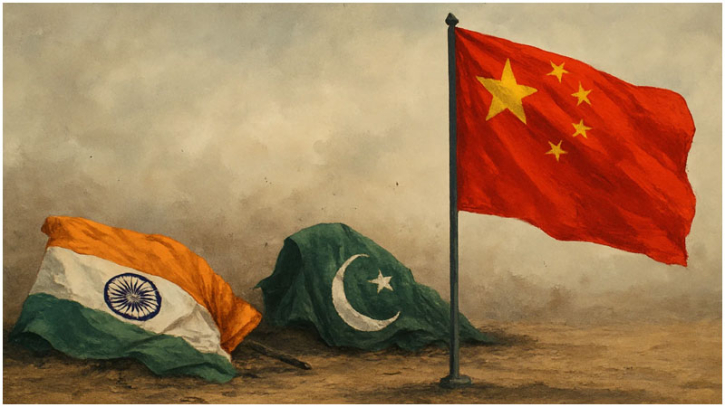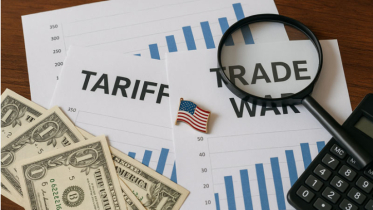India-Pakistan fought, China won

The fighting has stopped after four tense days between India and Pakistan, but the impact is still unfolding. In both government offices and newsrooms, people are trying to make sense of what happened.
Each country is calling it a win, though the verdict remains unclear. But while the focus stayed on the border, China kept quiet–– and quietly came out ahead.
It did not need headlines or missiles. Instead, it made its mark through rising stock prices, viral posts, and growing interest from buyers in the global arms market. No bombs were dropped, but the effects will last.
The recent escalation began with a massacre in Pahalgam on 22 April, where 26 people – mostly Indian tourists – were killed in an attack which Delhi blamed on Pak-backed militants.
The Indian Air Force (IAF) responded with "Operation Sindoor" on 7 May, targeting what it labelled "terrorist infrastructure" across the Line of Control.
Pakistan, in turn, launched a sharp counter. Its air force deployed an array of jets, including the Chinese-made J-10C and JF-17, reportedly downing multiple Indian aircraft in the process.
While India rejected claims of losses – Air Marshal A K Bharti simply remarked, "All our pilots are back home" – the details of the operation remained murky.
But amid the conflicting narratives, one detail caught the world's attention: the performance of Chinese aircraft in a live conflict.
For China, this was more than a regional dust-up. It was, in the words of People's Liberation Army (PLA) Rtd Senior Colonel Zhou Bo, "A big advertisement for the Chinese weapons industry. Until now, China has had no opportunity to test its platforms in a combat situation. This has changed that."
And the world noticed.
Shares in AVIC Chengdu Aircraft Company, the maker of the J-10, surged by 40% in a matter of days. On Chinese social media, unverified claims that Rafales had been downed by J-10Cs sparked waves of nationalist pride.
"Perception matters way more than reality. If we see it in that way, the main winner is really China," said Carlotta Rinaudo, a researcher in the China Unit at the Institute of International Studies in Verona.
That perception – whether grounded in hard data or not – has transformed into influence. Countries across Asia, Africa, and Latin America, long hesitant about Chinese military hardware due to reliability concerns, are now taking a second look.
For many of those countries, this was not just an Indo-Pakistan skirmish; it was a live demonstration of modern warfare between Western and Chinese systems.
The irony is stark. China has not fought a major war in more than four decades. Yet here it was, watching from the wings as its weapons were tested in one of the world's most volatile regions.
"This makes any engagement between India and Pakistan a test environment for Chinese military exports," said Sajjan Gohel, an international security expert based in London.
But China's gains go beyond just optics – they are deeply economic. With a booming arms export industry and global ambitions underpinned by Made in China 2025, Beijing's weapons manufacturers now stand at a crucial inflexion point.
The successful use–or perceived success–of its equipment gives China a powerful tool of influence, especially in nations seeking cost-effective, combat-tested alternatives to Western arms.
In 2023, China was already the fourth-largest arms exporter in the world. Now, boosted by this indirect baptism of fire, it is poised to move higher. Deals that had stalled over concerns of reliability, such as proposed sales to Egypt, Nigeria, and Argentina, are reportedly seeing renewed interest.
"This was not just a proxy skirmish. It was a showroom opening, a field-tested catalogue of Chinese military capabilities," said defence analyst Vipin Narang.
Arms aside, the alignment between Islamabad and Beijing runs deeper. With over $50 billion invested through the China-Pakistan Economic Corridor (CPEC), Beijing's interests in Pakistan are both economic and strategic.
As Pakistani analyst Imtiaz Gul put it, "It took the Indian planners by sheer surprise. They did not probably envision the depth of cooperation in the modern warfare between Pakistan and China."
From joint military drills to AI-assisted targeting systems, China has quietly embedded itself into Pakistan's military ecosystem.
As Craig Singleton of the Foundation for Defence of Democracies noted, "This is not just a bilateral clash anymore; it is a glimpse of how Chinese defence exports are reshaping regional deterrence."
What is more, this conflict has sent a message far beyond South Asia. To Southeast Asia, where countries are hedging between Beijing and Washington. To Latin America and Africa, where infrastructure deals increasingly come with defence packages.
And to Europe, where military planners are watching Beijing's arms diplomacy evolve into something more competitive, more agile, and – above all – more profitable.
India, meanwhile, finds itself caught between hard truths and harder optics. Its reliance on foreign hardware – French Rafales, Russian Sukhois – has left it vulnerable to perception-driven narratives.
The Rafale, once hailed as a game-changer, now faces reputational damage, not necessarily because it failed, but because its silence left a void that others rushed to fill.
Professor Walter Ladwig of King's College London highlighted this gap. "By refusing to get into the details of the mission briefing, India's military lost control of the narrative thread," he said.
And narratives matter – especially in a region where symbolism often overshadows substance.
This episode may well accelerate Delhi's push to modernise its defence industry, but it also underlines a growing asymmetry.
As India looked westward, to Washington, Paris, and Tel Aviv, for its military needs, Pakistan found China both as a supplier and a strategic partner willing to co-develop, co-invest, and co-operate.
Beijing, for its part, played its cards close to the chest. When asked about the reports of its jets downing Indian aircraft, a spokesperson simply said he was not aware of the situation. It was a masterclass in strategic ambiguity.
"China has spent billions developing military tech," said Zhou Bo. "And now, the world is finally watching."
Indeed, while Indian and Pakistani officials traded barbs and bombs, Beijing remained still, observing, absorbing, and advancing.
It did not need to fire a missile to register a victory. The clash gave its military-industrial complex the one thing it could not manufacture: credibility.
As Delhi and Islamabad wrestled for position under the gaze of a region long accustomed to tension, Beijing did not need to posture or provoke.
It watched. It learned.
And, crucially, it earned trust, interest, and influence. In the theatre of modern conflict, the most decisive act may not be to strike first, but to let others exhaust themselves while you prepare your move. In Sun Tzu's words: "The supreme art of war is to subdue the enemy without fighting." China may not have won the war, but it mastered the moment.
.png)




